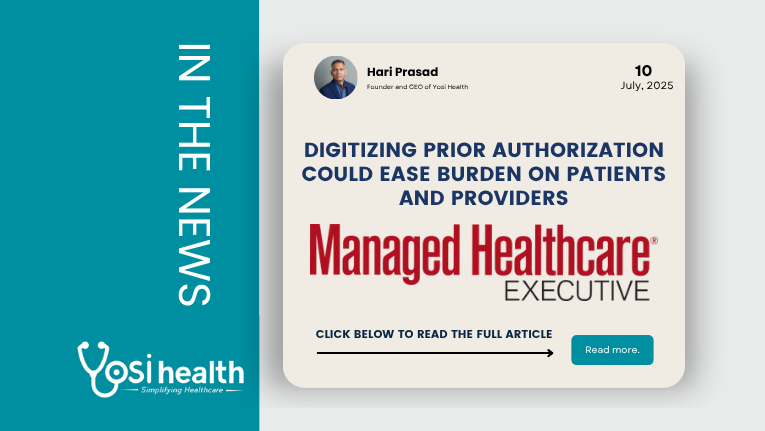
Hari Prasad
July 21, 2025
Emerging from the pandemic, virtual care has shown healthcare practices that telehealth is here to stay. But simply enabling video visits is just the beginning. To capitalize on virtual care’s benefits while avoiding common pitfalls, practices must thoughtfully address operational, clinical, and patient-experience challenges when evaluating additional virtual care options.

Here are five key considerations to help guide your virtual care strategy.
1. Seamless Integration with Existing Systems
Virtual visits should complement, not complicate, your current workflows. Practices often juggle the management of multiple platforms, including scheduling software, electronic health records (EHRs), billing systems, and patient portals. A fragmented approach creates data silos and increases administrative burden.
That’s why it’s important to look for telehealth solutions that offer bi-directional EHR integration, so that appointment details, encounter notes, and billing codes flow automatically into the patient’s record. Practices that achieve seamless integration report fewer documentation errors and faster revenue cycle turnaround. Mapping out the patient journey, from online scheduling through virtual check-in to post-visit billing, will ensure that every team member understands their role and can deliver a consistent experience.
2. Regulatory Compliance and Reimbursement Models
Telehealth regulations and payer policies continue to evolve. During the COVID-19 public health emergency, federal waivers and state “parity” laws expanded coverage for telehealth, but many of those flexibilities are now fading away. Practices must stay current onstate licensure requirements, controlled-substance prescribing rules, and Medicare/Medicaid reimbursement policies. Make sure your documentation meets Centers for Medicare & Medicaid Services (CMS) guidelines such as capturing visit start/end times, the modality used (video or audio), and the provider’s location. Likewise, confirm with commercial payers that virtual visits will be reimbursed at rates comparable to in-person encounters. Proactive monitoring of regulatory updates, from resources like the Center for Connected Health Policy, will protect your bottom line and prevent unwelcome reimbursement surprises.
3. Prioritize Cybersecurity and Patient Privacy
As virtual care expands, practices become responsible for securing sensitive health information across new digital channels. Telehealth platforms and patient portals must be fully HIPAA‑compliant, with end‑to‑end encryption to protect video streams and stored data. Practices should conduct regular risk assessments, apply multi‑factor authentication for both staff and patients, and ensure software patches are installed promptly. Staff training is also critical; any team member handling patient data needs clear protocols for secure password management, recognizing phishing attempts, and reporting breaches. By making cybersecurity a foundational element of your virtual care strategy, you safeguard patient trust, avoid costly data breaches, and ensure regulatory compliance as telehealth becomes a core practice modality.
4. Staff Training and Change Management
Rolling out virtual care isn’t simply a tech deployment; it’s an organizational transformation. Administrative and clinical staff need to understand not only how to use telehealth platforms, but also when to triage patients to virtual versus in-person visits. Establish clear protocols detailing which conditions or visit types, such as medication refills, mental health check-ins, or follow-up consultations, are appropriate for telehealth. Provide hands-on training sessions, quick-reference guides, and ongoing tech support so your team feels confident troubleshooting connectivity issues or guiding patients through the process. When staff feel empowered, they can focus on patient care rather than technical problems, boosting both efficiency and satisfaction on both sides of the screen.
5. Maximizing Patient Engagement and Experience
Virtual care can be convenient, but it risks feeling impersonal if not executed thoughtfully. Patients value transparency around costs and care expectations. Integrate online scheduling that displays real-time availability, automated appointment reminders via text or email, and secure portals where patients can complete intake forms and view estimated copays ahead of their visit. Clear communication about audio-only versus video visit requirements, how to log in, and what to expect during the virtual encounter reduces “no-shows”; practices that implement robust pre-visit engagement see attendance rates climb by up to 25%. After each visit, solicit feedback through brief surveys to surface usability issues or workflow improvements. Satisfied patients will be more likely to return and to recommend your practice to family and friends, extending the benefits of virtual care well beyond a single appointment.
Looking Ahead
Integrating virtual care into your practice is not a one-time project but an ongoing evolution. By focusing on integration, compliance, digital equity, staff readiness, and patient engagement, you can build a robust hybrid care model that expands access, streamlines operations, and enhances outcomes. As technology advances, from remote monitoring devices to AI-driven virtual assistants, practices that establish a strong foundation today will be best positioned to adapt and thrive in the healthcare landscape of tomorrow.

Hari Prasad
CEO at Yosi Health
Hari Prasad is the CEO of Yosi Health, a digital front-office automation platform that helps healthcare practices streamline patient intake, virtual visits, and payment workflows. With more than a decade of experience in health-tech innovation, he guides practices in implementing patient-centric solutions that drive engagement and efficiency.
Click to Read the full article here.












